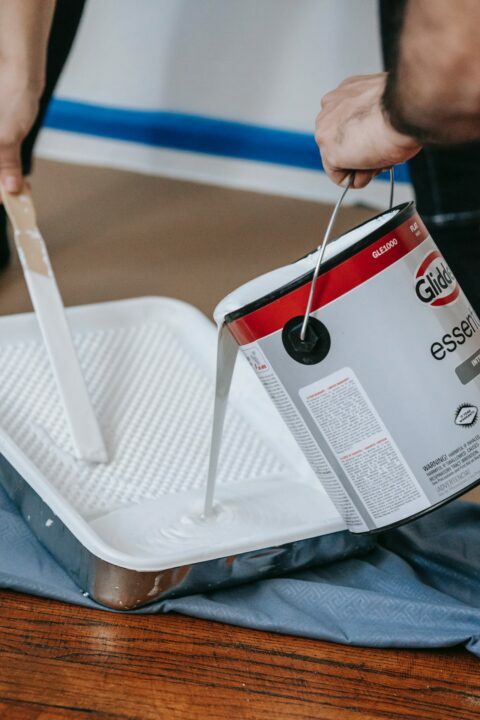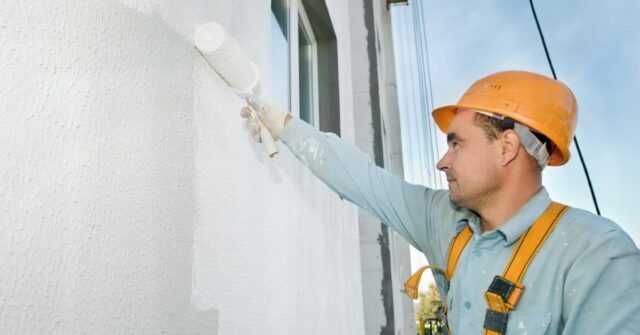Choosing the right exterior paint for your home is crucial in enhancing your home’s curb appeal, preserving the structural integrity of your building, and ensuring the exterior withstands the elements.
In Australia, this task can be somewhat challenging due to the unique climate conditions. However, with the right guidance and information, you can make a choice that will suit your home perfectly.
This article aims to guide you through the process and factors to consider when choosing exterior paint for your Australian home.


Understanding Australia’s Unique Climate Conditions
Australia’s weather varies dramatically across the country, making it essential to consider the specific climate conditions of your location when choosing exterior paint.
From harsh sunlight and UV rays to high temperatures, cold winters, and salt air in coastal regions, these conditions can significantly impact the durability and appearance of your paintwork.
The Impact of Sunlight and UV Rays
Most parts of Australia experience high levels of sunlight and UV radiation, which can lead to paint fading and degradation.
When choosing your exterior paint, opt for products specifically designed to withstand intense UV radiation.
Effects of Salt Air in Coastal Regions
If you live in a coastal area, your home is frequently exposed to salty sea air. This salt can cause paint to chip and degrade faster than it normally would.
Therefore, choosing a paint designed to withstand these salty conditions can help extend the lifespan of your home’s exterior paintwork.
Dealing With High Temperatures and Drought
High temperatures and drought common in many parts of Australia can also affect your exterior paint. It’s vital to choose a paint that can handle these extreme conditions without cracking or peeling.
Preparation for Cold and Frosty Winters
In colder regions experiencing frosty winters, your exterior paint must be able to resist freezing and thawing cycles.
This is where special cold-weather paints come in handy, offering better durability in cold conditions.
Identifying the Material of Your Home’s Exterior
The material of your home’s exterior also plays a significant role in the type of paint you should choose.
Different materials absorb and react to paint in different ways, so it’s essential to identify your home’s material and choose a suitable paint accordingly.
Wood
Wood is a common material for home exteriors, appreciated for its natural beauty and versatility. However, it’s also susceptible to moisture and can warp, rot, or develop mould.
Therefore, when painting a wooden exterior, it’s important to use a paint that’s designed for wood, preferably one that includes fungicides and is highly resistant to moisture.


Brick
Brick exteriors are renowned for their durability and low maintenance. Yet, over time, bricks can lose their lustre and may require a fresh coat of paint.
Use a paint that can adhere to the brick’s porous surface and withstand its expansion and contraction due to temperature changes.
Also, priming before painting brick is crucial to prevent the paint from peeling or blistering.
Stone
Stone exteriors add a timeless charm to any home. But like brick, stone is porous and requires a specific type of paint.
Use breathable, high-quality masonry paint to allow moisture to escape and prevent peeling or flaking. A durable, weather-resistant paint is also recommended to maintain the stone’s natural look.


Metal
Metal exteriors, including steel or aluminium siding, need paint that adheres well to metal and resists rust.
Look for paints specifically formulated for metal surfaces, and consider a primer that inhibits rust for better durability and a smoother finish.
Render
Rendered homes are quite popular in Australia. This type of surface requires a paint that can handle its porous nature.
Acrylic paints are often a good choice due to their durability and flexibility, which help cope with the natural movement of the building without causing the paint to crack.
Vinyl
Vinyl siding is low-maintenance and durable, but it can fade over time. When painting vinyl, choose a light colour, as darker shades can absorb heat and cause the siding to warp.
Also, use a paint specifically designed for vinyl for better adhesion and durability.
Types of Exterior Paints
There are numerous types of exterior paints available on the market, each with its unique properties and benefits.
Understanding these types can help you make a more informed decision that fits your home’s specific needs.


Water-Based Paints
Water-based or latex paints are popular for their easy application and quick drying time. They offer excellent colour retention, are flexible, and are resistant to cracking.
These paints are also environmentally friendly, as they have lower levels of volatile organic compounds (VOCs).
Oil-Based Paints
Oil-based paints are renowned for their durability and rich, smooth finish. They are especially suitable for surfaces that require heavy-duty protection, like metal or areas prone to wear.
However, they take longer to dry and have a higher VOC content than water-based paints.
Acrylic Paints
Acrylic paints are a type of water-based paint but with added acrylic for improved durability and finish. They offer excellent adhesion, resist fading, and are less likely to crack or peel.
This type of paint is perfect for most exterior surfaces, including wood, brick, and render.
Latex Paints
Latex paints, another subset of water-based paints, are appreciated for their ease of application and clean-up, durability, and resistance to mildew and fading.
They are ideal for a variety of exterior surfaces and weather conditions, making them a versatile choice for many homeowners.
Factors to Consider When Choosing Exterior Paint
Choosing the right exterior paint involves considering several factors.
Apart from the material of your home’s exterior and the type of paint, you also need to consider colour, durability, environmental impact, maintenance, and cost.


Colour Selection and Aesthetics
Colour is a crucial factor as it directly affects the aesthetic appeal of your home. Consider the architectural style of your house, the surrounding landscape, and neighbourhood norms.
Keep in mind that lighter colours can help keep your home cool in hot climates by reflecting sunlight, while darker colours can absorb heat.
Durability and Weather Resistance
The paint you choose should be able to withstand the specific weather conditions of your area. Look for paints labelled as weather-resistant or those specifically designed for certain climates.
The paint should also be durable to resist chipping, peeling, and fading over time.
Environmental Impact
Consider the environmental impact of the paint. Water-based paints generally have lower VOCs than oil-based ones, making them a more environmentally friendly choice.
Some paints are also labelled as ‘eco-friendly’ or ‘green’.
Maintenance and Cleaning
Exterior paint requires occasional cleaning to maintain its look. Choose a paint that’s easy to clean and resists dirt and stains. Some paints even offer self-cleaning technology.
Cost and Budgeting
Cost is an important factor to consider.
While you might be tempted to go for the cheapest option, remember that quality paints often offer better coverage and longevity, which can save you money in the long run.
Priming Your Home’s Exterior
Priming is a crucial step in the painting process. It helps the paint adhere better to the surface, increases the paint’s durability, and provides additional protection for the material beneath.


Why Priming is Essential
A good primer seals the surface, fills in small holes and imperfections, and makes the paint colour look better and more vibrant.
It can also prevent stains and knots from showing through the paint, especially in wood exteriors.
Choosing the Right Primer
The type of primer you should use depends on the material of your home’s exterior and the type of paint you’re using.
There are oil-based, latex-based, and shellac primers, each suitable for different situations. Some paints also come with primer included, offering a time-saving option.
Application Techniques
The method you use to apply the paint can greatly affect the final outcome. Each technique – brushing, rolling, and spraying – has its own set of advantages and is suited to specific situations.
Brushing
Brushing allows for excellent control and is perfect for smaller, intricate areas, such as trims and corners.
It’s also ideal for textured surfaces where a brush can get into nooks and crannies that rollers or sprayers might miss.
Rolling
Rolling is a quick and efficient method for painting large, flat areas. It provides a smooth, even finish, but might not be as effective on heavily textured surfaces.
Spraying
Spraying is the fastest method and can cover a large area in a short time. It’s ideal for textured surfaces and gives a smooth finish.
However, it requires more preparation to protect surrounding areas from overspray and might not be suitable for windy days.
Choosing a Professional Painter vs DIY
Deciding whether to paint your home yourself or hire a professional depends on several factors, including cost, time, and the complexity of the job.


Understanding the Costs
While hiring a professional painter might seem expensive upfront, it can save you money in the long run.
Professionals have the skills and experience to do the job right the first time, reducing the chance of costly mistakes. Plus, they can often get trade discounts on paint and materials.
Evaluating the Time Commitment
Painting a house is a time-consuming process. If you don’t have the time or the patience for the job, hiring a professional might be a better choice.
They can complete the job quickly and efficiently, causing less disruption to your daily routine.
Quality and Warranty Considerations
Professional painters can provide a high-quality finish that might be difficult to achieve if you’re not experienced. They also often offer warranties on their work, providing peace of mind.
Common Mistakes to Avoid
When painting your home’s exterior, it’s crucial to avoid certain common mistakes that can affect the final result.
These include not preparing the surface properly, using the wrong type of paint, and painting in adverse weather conditions.
Understanding and Following Australian Regulations
In Australia, certain regulations govern the use of paints, especially those containing hazardous substances.
Make sure you understand and follow these regulations to ensure your safety and protect the environment.


Maintaining Your Home’s Exterior Paint
Maintaining your home’s exterior paint can prolong its lifespan and keep your house looking its best. Regular cleaning, touch-ups, and knowing when to repaint are all part of paint maintenance.
Regular Cleaning
Regularly cleaning your home’s exterior can prevent dirt and dust build-up, which can cause the paint to degrade over time. Use a soft brush or low-pressure hose to gently clean the surface.
Touch-ups and Repairs
Touch-ups can keep your paint looking fresh and vibrant. Whenever you notice any chipping or peeling, touch up the area with some leftover paint.
If there’s damage to the surface, make sure to repair it before touching it up to prevent further problems.
When to Repaint
Generally, a good quality paint job should last 5-10 years. Signs that it’s time to repaint include fading, chipping, peeling, or if the paint no longer repels water.
Conclusion
Choosing the right exterior paint for your Australian home involves considering many factors, from the unique climate conditions and the material of your home’s exterior to the type of paint and colour.
By understanding these factors and following the guidelines in this article, you can make a choice that will not only enhance your home’s aesthetic appeal but also protect it from the elements for years to come.





